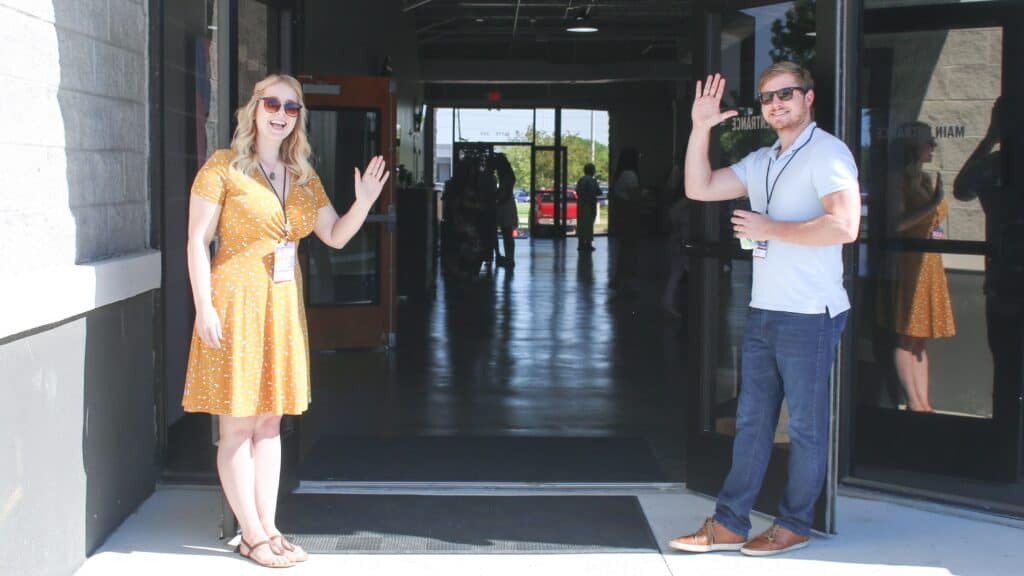Churches often face the difficult task of balancing openness and safety. Religious institutions strive to maintain an atmosphere this is welcoming and calming. However, tragic events targeting churches have created the need for increased security measures, raising questions on how to create a safe environment without compromising the welcoming nature that churches are known for.
Addressing this challenge requires careful thought and planning. Staff members and volunteers must work together to create policies and practices that offer an adequate level of protection while still fostering a sense of community. This may include implementing a secure check-in system for children and events, training greeters, and ushers to be vigilant, and regularly evaluating church safety protocols. By integrating these practices, churches can confidently offer a sanctuary where openness and safety coexist harmoniously.
Understanding the Prevalence of Church Security Issues
Notable Church Shooting Incidents
In recent years, there have been several high-profile incidents of violence against churches, with mass shootings being some of the most devastating examples. One tragic event occurred in Sutherland Springs, Texas, in 2017, when a gunman killed 26 people during a Sunday worship service. Another infamous incident took place in 2015, at the Emanuel African Methodist Episcopal Church in Charleston, South Carolina, where a shooter claimed the lives of nine churchgoers.
The Risks Faced by Congregations
Churches and other houses of worship face a unique balancing act as they strive to maintain open and welcoming environments while ensuring the safety of their congregations. In addition to the threat of mass shootings, congregations must also be aware of risks such as verbal and physical altercations, arson, threats, and vandalism. To address these concerns, churches often implement a combination of physical security measures, such as video surveillance, alarm systems, and security staff, as well as training for volunteers and staff members to provide guidance and be prepared in the event of an emergency.
The challenge of church security is a pressing one, as incidents of gun violence and other forms of violence continue to make headlines. By understanding the risks faced by congregations and the steps taken to address these concerns, church leaders can work towards creating a safer and more secure environment for their communities.
Developing a Comprehensive Church Security Plan
In today’s world, ensuring the safety and security of churches has become a top priority. Balancing openness and safety can be challenging, but it’s essential for church leaders to create a comprehensive security plan. A well-structured plan, incorporating various aspects of security, enables faith-based organizations to provide a safe environment while still maintaining an open, inviting atmosphere.
An essential component of a church security plan is risk assessment, which involves identifying potential threats and vulnerabilities. By evaluating risks, church leaders can prioritize and implement appropriate security measures. This includes addressing both physical and cyber threats to safeguard congregations and resources.
Establishing a specialized security team is a critical step in creating a church security plan. The team can consist of staff members or volunteers trained in safety procedures, monitoring systems, emergency response, and conflict resolution. This team should collaborate with church leaders and administrators to develop and implement a proactive strategy for addressing safety concerns.
Church leaders should stay informed about potential threats and communicate them effectively to the congregation. By keeping members informed, they can foster a sense of vigilance and encourage everyone to contribute to the security of the faith community. It’s also crucial to establish clear guidelines for reporting suspicious activities or incidents to maintain a secure environment.
Resources, such as the Department of Homeland Security’s Safety for Faith-Based Events and Houses of Worship, can offer churches additional guidance and information on assessing and addressing potential risks. These resources can help church leaders make informed decisions, invest in appropriate security solutions, and train their personnel to respond effectively in potentially dangerous situations.
Finally, contingency planning is essential for church security. Churches should develop action plans for various scenarios, including natural disasters, medical emergencies, and active shooter situations, to ensure they can respond quickly and effectively in a crisis. Regular training, drills, and evaluation of the security plan will help ensure that church members and staff are knowledgeable about their roles and responsibilities in maintaining a safe and secure environment.
Developing a comprehensive church security plan is an ongoing process that requires dedication and attention from church leaders and their security teams. By taking a proactive approach, faith-based organizations can strike the right balance between creating an open, inviting atmosphere and ensuring the safety of their congregations.
Assessing and Strengthening Physical Security
Assessing and improving the physical security of church property is crucial to ensure a balance between openness and safety. Churches must take several factors into consideration, including potential theft, fire hazards, and implementing appropriate security measures.
One important step in strengthening physical security is to conduct a thorough assessment of the church facilities. This evaluation should focus on identifying potential areas of vulnerability, such as poorly-secured doors and windows or lack of security cameras. Once areas of weakness have been identified, appropriate measures can be taken to address these issues and improve overall safety.
Incorporating technology and surveillance equipment can effectively boost physical security on a church campus. The installation of security cameras around the property, including parking lots and the exterior of the building, can act as a deterrent to criminal activity and help identify any threats. Additionally, implementing access control systems for church doors can prevent unauthorized entry while still maintaining a welcoming atmosphere for the community.
Fire safety is another vital aspect of physical security for churches. Ensuring proper maintenance of fire alarms and extinguishers, along with clear safety protocols and evacuation procedures, can protect both the facility and the congregation from potential fire hazards.
Effective communication and support play a crucial role in maintaining a secure environment. Establishing a security team or ministry that includes church staff and volunteers can help foster a sense of trust and unity. This team should be knowledgeable about the church’s security measures and be able to communicate with local emergency responders in case of a critical situation.
In conclusion, by carefully assessing and strengthening the physical security of a church, communities can confidently enjoy a safe and welcoming environment, where they can focus on their spiritual connection and growth.
Implementing Background Checks and Screening Procedures
Benefits of Background Checks
Implementing background checks is an essential step towards maintaining security at a church. By conducting these checks, the congregation can maintain a safer environment for members, volunteers, and children. Background checks enable churches to identify individuals with past criminal records or other red flags before they become a part of the church community. This proactive measure helps protect vulnerable individuals, ensures a high-quality and diverse workforce, and contributes to building trust among church members, staff, and trustees.
Volunteer and Staff Screening
In addition to background checks, it is crucial for churches to establish a thorough screening process for volunteers and staff members. This process should involve a combination of child safety training and church background checks to minimize the risk of abuse and protect the congregation from potential allegations of abuse.
Key aspects of an effective screening policy for church volunteers and staff may include:
- Clearly outlining the criteria for eligibility, such as age requirements or prior experience.
- Requiring applicants to complete a comprehensive application form, providing personal and professional references.
- Conducting face-to-face interviews to assess an individual’s suitability for the role and compatibility with the church’s values and mission.
- Providing regular training and education on the church’s safety policies and procedures.
Ultimately, implementing a robust background check and volunteer screening process will help churches balance openness and safety, ensuring a secure and welcoming environment for all members of the congregation.
Cooperating with Local Law Enforcement
Establishing a strong and ongoing relationship with local law enforcement is a crucial element of church security. Cooperation between the church and law enforcement ensures a safer and more secure environment for congregants and visitors alike. By connecting with the police, churches can share information, increase awareness of potential threats, and collaborate on effective measures that enhance safety.
One way to initiate collaboration is by inviting law enforcement officers to speak at church meetings or events. This allows the church community to learn about local security threats and develop a better understanding of safety precautions. Moreover, it demonstrates a commitment to partnership and creates trust between church-goers and police officers.
To further enhance church security, it is crucial to establish clear communication channels with local law enforcement. This can involve creating a protocol for sharing information about potential threats, suspicious activities, or security incidents. Developing an open line of communication enables fast and efficient responses in case of emergencies.
Furthermore, it is essential to include law enforcement in emergency response planning. Integrating their expertise in developing evacuation procedures, emergency communication strategies, and threat assessment helps ensure readiness and effectiveness in the face of critical events. Collaboration between churches and law enforcement can also include joint training sessions or workshops that enhance the skills of church security teams.
In conclusion, fostering cooperation with local law enforcement significantly contributes to keeping a church and its congregation safe. By nurturing a strong partnership, sharing information, and receiving guidance on security best practices, religious institutions can better protect their communities and uphold their values of safety, openness, and peace.
Prioritizing Emergency Preparedness and Training
Emergency preparedness and training should be a priority within any organization, including houses of worship. Effective planning and training can help prevent tragic events and better equip staff and volunteers to properly respond when emergencies arise. This section will cover two essential aspects of church security: Fire Safety and Evacuation Planning, and Active Shooter Response Training.
Fire Safety and Evacuation Planning
A thorough fire safety and evacuation plan is crucial for safeguarding the congregation and any visitors. Regularly inspect and maintain fire alarms, sprinkler systems, and fire extinguishers to ensure they are in good working order. Additionally, ensure the following actions are taken:
- Develop a comprehensive evacuation plan that includes multiple exit routes.
- Clearly mark all exits and post evacuation maps in easily accessible locations.
- Regularly review and practice evacuation procedures with staff, volunteers, and congregation members.
- Consider inviting local fire department personnel to teach fire safety classes or provide guidance on best practices.
By investing time and resources into fire safety, you can help ensure a safer environment for all those who enter the house of worship.
Active Shooter Response Training
In addition to fire safety, active shooter response training is an essential component of church security. This training helps to prepare individuals for the unimaginable possibility of deadly force being used against them in their place of worship. The following are some key aspects to consider:
- Organize active shooter response training sessions for staff, volunteers, and congregation members.
- Ensure the training covers important topics, such as communication, lockdown procedures, and potential lifesaving actions.
- Collaborate with local law enforcement agencies for expert advice on best practices and strategies for houses of worship dealing with active shooter situations.
By placing an emphasis on emergency preparedness and training, your house of worship can maintain a balance between openness and safety. Through regular training events and collaboration with local authorities, you can provide a secure environment for your congregation and visitors while remaining a welcoming and inclusive space.
Fostering Openness and Welcoming Environment

Churches play a pivotal role in creating a sense of community and shared beliefs. Fostering an open and welcoming environment is crucial for attracting new members, and worshippers, and maintaining a vibrant community. However, it is equally essential to focus on church safety to provide a secure and enriching experience for the congregation.
Clear communication is an essential aspect of fostering a welcoming environment. Churches should provide relevant information about worship services, activities, and support programs on their websites and social media platforms. This not only ensures transparency but also helps potential members and worshippers feel informed and welcomed. Creating a user-friendly online presence helps in reaching out to a broader audience and allows people to participate in church activities virtually.
Physical accessibility plays a crucial role in creating an open and welcoming environment. It is vital to ensure that churches are accessible to people with disabilities, elderly members, and families with young children. Having ramps, elevators, and accessible restrooms can significantly contribute to creating an inclusive atmosphere for everyone.
Greeting attendees as they enter the church is a simple yet effective way to make visitors feel welcome. Designating friendly and approachable individuals as greeters, who can also act as a point of contact for newcomers, can facilitate a sense of belonging. Assigning volunteers to assist newcomers in finding seating, understanding the order of service, and introducing them to other members ensures they feel included and valued.
In terms of church safety, implementing security measures can help protect the congregation while maintaining a sense of openness. Installing surveillance cameras at strategic locations and routinely checking them can serve as a deterrent to potential threats. Organizing regular safety training sessions for staff and volunteers allows them to identify and respond effectively to emergencies. Collaborating with local law enforcement agencies on safety measures and planning can further strengthen the church’s security efforts.
In conclusion, balancing openness and safety in churches is indeed a delicate task. Achieving this balance involves implementing versatile strategies in communication, accessibility, and security. With careful planning and a conscious effort to prioritize both openness and safety, churches can foster a warm and welcoming environment that caters to the needs of their diverse congregation.
Leveraging Technology and Tools for Enhanced Security
In recent years, churches have faced numerous security challenges due to unfortunate incidents. To ensure the safety of congregations, many churches are adopting advanced security measures by leveraging the latest technology. By doing so, they aim to strike a balance between maintaining openness and ensuring safety for the church community.
One of the most common tools employed by churches is the installation of security cameras. These cameras, strategically positioned throughout the campus and other parts of the church property, provide real-time monitoring and recording capabilities. They serve as an essential deterrent to potential wrongdoers, while also enabling prompt response in case of emergencies or security breaches.
Another useful security measure is implementing access control systems. These systems limit and monitor access to certain areas within the church premises, ensuring that unauthorized personnel are not granted access to sensitive locations. By allowing only authorized individuals to access specific areas, churches can maintain both openness for congregation members and increased safety through controlled access.
In addition to physical security measures, churches must also consider the protection of their information and communication systems. They can achieve this by deploying an appropriate cybersecurity infrastructure that includes firewalls, antivirus programs, and secure communication platforms. Regularly updating software and educating staff members about potential threats and best practices further enhance a church’s digital security.
Churches can also benefit from integrating various security systems into a centralized platform, allowing for more efficient monitoring and management. Such platforms enable the church security team to quickly identify potential threats and take appropriate actions in emergency situations.
In conclusion, leveraging technology and tools for enhanced security is critical for churches striving to balance openness and safety. By employing a combination of security cameras, access control systems, cybersecurity measures, and integrated platforms, churches can create a secure and welcoming environment for their congregations.
Building Trust and Communication Among Members
A critical aspect of balancing openness and safety in church settings is fostering trust and effective communication among congregation members. Building trust among worshippers creates an environment where everyone feels secure while also allowing for the exchange of information. This shared, common ground is crucial in detecting and addressing potential violence in a timely manner.
One approach to achieving this trust and communication is by implementing an ongoing education and awareness program for the congregation and church staff. These programs can encompass topics such as safety measures, emergency response plans, and sharing relevant information about possible threats. By consistently providing this information, members will become more confident in their roles as guardians of the church’s safety.
Moreover, fostering a sense of community among worshippers is equally important. Encourage the congregation to participate in various activities, where they can interact more closely and develop closer bonds. Engagement in social gatherings, volunteer work, and Bible study groups can contribute significantly to building trust and promoting open communication among members.
Transparent communication from church leadership is also vital in building trust among members. Church leaders should regularly inform the congregation about safety and security measures in place, addressing any concerns raised by members. This display of honesty and openness can help alleviate potential anxieties and reinforce the congregation’s trust in church management.
Finally, the utilization of technology, such as an online reporting system or a mobile app, can support communication efforts. These channels allow the congregation to share information about suspicious behavior or potential threats in a timely and discreet manner, further enhancing the sense of safety and trust within the church.
By emphasizing the importance of trust and communication among the congregation, churches can create an environment where members feel protected and engaged while managing the delicate balance between openness and safety in a religious setting.
Conclusion
The challenge of church security lies in striking the right balance between remaining open and welcoming to all while ensuring the safety of congregation members. In today’s world, churches must remain vigilant against potential threats, such as shootings, violence, and other safety concerns.
To address these issues, many churches have implemented security measures, including forming church security teams, installing cameras and alarms, and conducting emergency drills with members and church officials. While some measures, such as background checks for volunteers and staff, might feel invasive, they contribute to a more secure environment within the church.
However, the ultimate goal for churches should be to create a sense of safety without compromising the open and welcoming atmosphere that is integral to the congregation’s spiritual well-being. Implementing carefully considered security measures and training can help achieve this delicate balance. By fostering a secure environment, churches can continue to be a beacon of hope and support for their members and the wider community.
Frequently Asked Questions
What are the best practices for implementing church security?
Implementing church security involves a multi-faceted approach. This includes assessing vulnerabilities, creating guiding policies, and establishing specific procedures. Some best practices include having a security team, implementing access control measures, conducting regular security assessments, and collaborating with local law enforcement. It’s essential to create a safety plan to address potential risks.
How to balance safety measures with maintaining a welcoming atmosphere?
Balancing safety and openness requires communication, understanding, and flexibility. Encourage church staff, volunteers, and congregation members to prioritize both safety and hospitality. Security measures should not impede a welcoming environment, and it’s crucial to promote a positive and inclusive atmosphere. Effective communication and training can help foster a balance between safety and openness in a church setting.
What role do volunteers play in maintaining church safety?
Volunteers, such as greeters and ushers, play a significant role in maintaining church safety. Their primary responsibility is to provide a welcoming environment while also acting as an essential part of the security team. These volunteers should receive training in identifying possible risks, responding to emergencies, and alerting appropriate personnel if necessary. The role of greeters and ushers in church security is vital for maintaining a safe and welcoming atmosphere.
How can technology be utilized for enhancing church security?
Technology can play an essential role in increasing church security. Surveillance cameras, alarm systems, and access control measures can help secure church premises efficiently. Investing in advanced technology solutions, such as video analytics and remote monitoring, can aid in identifying risks and responding to incidents in real-time. Technology can also help provide training and communication tools for security teams, enhancing overall safety efforts.
What kind of training programs should be in place for church security personnel?
Training programs for church security personnel should cover essential aspects of safety and security, violence prevention, and emergency response. These programs can be tailored to meet the specific needs of each church and its community. Training modules should address topics such as situational awareness, evacuation procedures, medical emergencies, and communication. Regular, ongoing training is crucial for maintaining a safe environment.
How to address potential legal issues related to church safety?
Potential legal issues related to church safety can include liability, negligence, and compliance concerns. To navigate these issues, churches should consult with legal professionals and be knowledgeable about local, state, and federal laws governing places of worship. In addition, churches must create and enforce security policies and procedures to minimize potential legal problems. Proper documentation, record-keeping, and communication can also aid in addressing legal concerns related to church safety.








